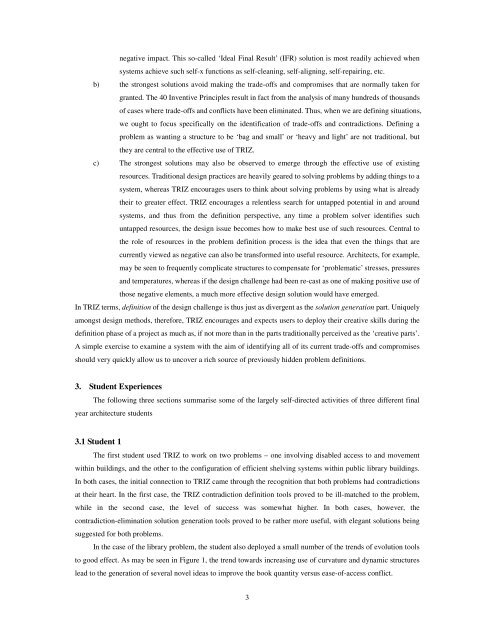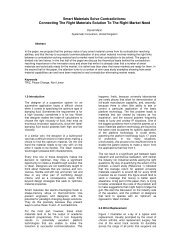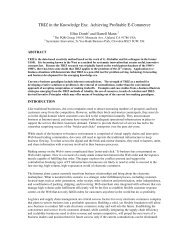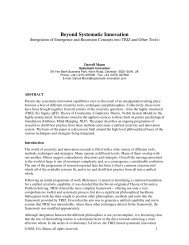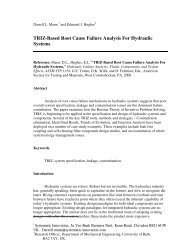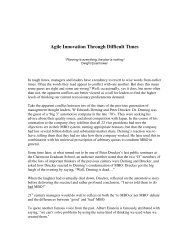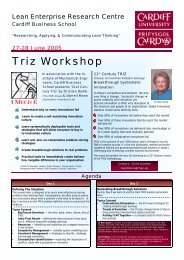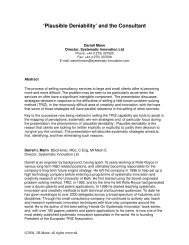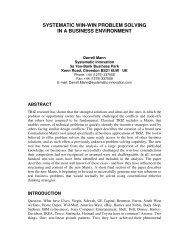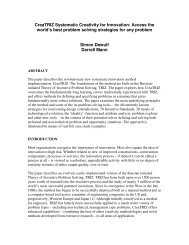Using TRIZ In Architecture: First Steps - Systematic Innovation
Using TRIZ In Architecture: First Steps - Systematic Innovation
Using TRIZ In Architecture: First Steps - Systematic Innovation
You also want an ePaper? Increase the reach of your titles
YUMPU automatically turns print PDFs into web optimized ePapers that Google loves.
negative impact. This so-called ‘Ideal Final Result’ (IFR) solution is most readily achieved when<br />
systems achieve such self-x functions as self-cleaning, self-aligning, self-repairing, etc.<br />
b) the strongest solutions avoid making the trade-offs and compromises that are normally taken for<br />
granted. The 40 <strong>In</strong>ventive Principles result in fact from the analysis of many hundreds of thousands<br />
of cases where trade-offs and conflicts have been eliminated. Thus, when we are defining situations,<br />
we ought to focus specifically on the identification of trade-offs and contradictions. Defining a<br />
problem as wanting a structure to be ‘bag and small’ or ‘heavy and light’ are not traditional, but<br />
they are central to the effective use of <strong>TRIZ</strong>.<br />
c) The strongest solutions may also be observed to emerge through the effective use of existing<br />
resources. Traditional design practices are heavily geared to solving problems by adding things to a<br />
system, whereas <strong>TRIZ</strong> encourages users to think about solving problems by using what is already<br />
their to greater effect. <strong>TRIZ</strong> encourages a relentless search for untapped potential in and around<br />
systems, and thus from the definition perspective, any time a problem solver identifies such<br />
untapped resources, the design issue becomes how to make best use of such resources. Central to<br />
the role of resources in the problem definition process is the idea that even the things that are<br />
currently viewed as negative can also be transformed into useful resource. Architects, for example,<br />
may be seen to frequently complicate structures to compensate for ‘problematic’ stresses, pressures<br />
and temperatures, whereas if the design challenge had been re-cast as one of making positive use of<br />
those negative elements, a much more effective design solution would have emerged.<br />
<strong>In</strong> <strong>TRIZ</strong> terms, definition of the design challenge is thus just as divergent as the solution generation part. Uniquely<br />
amongst design methods, therefore, <strong>TRIZ</strong> encourages and expects users to deploy their creative skills during the<br />
definition phase of a project as much as, if not more than in the parts traditionally perceived as the ‘creative parts’.<br />
A simple exercise to examine a system with the aim of identifying all of its current trade-offs and compromises<br />
should very quickly allow us to uncover a rich source of previously hidden problem definitions.<br />
3. Student Experiences<br />
The following three sections summarise some of the largely self-directed activities of three different final<br />
year architecture students<br />
3.1 Student 1<br />
The first student used <strong>TRIZ</strong> to work on two problems – one involving disabled access to and movement<br />
within buildings, and the other to the configuration of efficient shelving systems within public library buildings.<br />
<strong>In</strong> both cases, the initial connection to <strong>TRIZ</strong> came through the recognition that both problems had contradictions<br />
at their heart. <strong>In</strong> the first case, the <strong>TRIZ</strong> contradiction definition tools proved to be ill-matched to the problem,<br />
while in the second case, the level of success was somewhat higher. <strong>In</strong> both cases, however, the<br />
contradiction-elimination solution generation tools proved to be rather more useful, with elegant solutions being<br />
suggested for both problems.<br />
<strong>In</strong> the case of the library problem, the student also deployed a small number of the trends of evolution tools<br />
to good effect. As may be seen in Figure 1, the trend towards increasing use of curvature and dynamic structures<br />
lead to the generation of several novel ideas to improve the book quantity versus ease-of-access conflict.<br />
3


